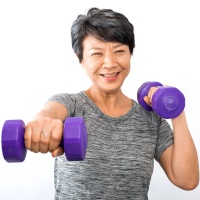
Physical activity of any sort—traditional exercise, household chores, yard work, walking the dog, etc.—packs a positive punch that becomes even more important as we age. According to the National Institute on Aging, exercise may delay or prevent many age-related diseases, such as diabetes, colon cancer, heart disease, and stroke. Being physically active has also been proven to help build strength, improve balance, reduce depression, increase energy, and maintain brain health and cognition—all key factors for living independently.
“Almost every client I work with would much prefer to stay in their own home instead of moving to a facility,” said Lifespark Home Health occupational therapist, Janice Gross, OTR/L, ATP. “That’s not always safe or realistic, but when someone is highly motivated to stay independent, it’s amazing what they can accomplish.”
Even clients whose diabetes has resulted in a lower limb amputation, a stroke, or arthritis can gain the strength and mobility they need to manage their activities of daily living. But there’s another, equally important benefit: “Being able to get in and out of bed, take a shower, put together a healthy meal, or make a smoothie does wonders for a person’s sense of self-worth and independence,” she said, adding that when clients become more self-sufficient, they can also reduce their reliance on caregivers.
Exercise with a purpose
Education plays a big part in getting clients on board, said Janice. “Once people understand why they need to move—to lubricate their joints, take pressure off their butt, feel more alert—they’re willing to give it a go.”
To keep her clients motivated, Janice ties her recommendations to the individual’s goals. “One gentleman wanted to decrease a medication he was taking, so we created a plan that would help him burn calories, lose weight, and lower his need for the drug,” she explained. Another client wanted relief from her shoulder pain, so Janice gave her a set of exercises that would increase her range of motion and reduce inflammation.
No-sweat activity
Unless the goal is to run a 10K, exercise doesn’t have to be exhausting—or even sweaty. In fact, for people with diabetes, moderate activity for longer periods helps the body use glucose more efficiently, and that in turn helps lower blood sugar levels.
Janice offered the following suggestions for incorporating physical activity into everyday life:
- Stand up and sit down five times during commercial breaks
- Do bicep curls using water bottles or soup cans
- Do leg lifts while watching TV or talking on the phone
- Walk around the living room, down the hall, or up the stairs
- Fill a jar with pennies and place on the kitchen counter; move one penny at a time to a jar in the living room; when you’ve moved all the pennies, buy yourself some flowers or a fancy tea
Bottom line, staying active can help you live a happier, healthier, more independent life!
Connect with Lifespark today and get moving – schedule a free consultation



